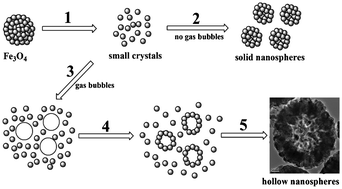Building on size-controllable hollow nanospheres with superparamagnetism derived from solid Fe3O4 nanospheres: preparation, characterization and application for lipase immobilization
Abstract
Monodisperse porous hollow nanospheres with superparamagnetism were prepared via a hydrothermal reaction based on solid Fe3O4 nanospheres. By investigating the effect of carbon precursors, the kinds and amounts of structure-directing agents and the reaction time on the formation of hollow spheres, it was proposed that the main formation mechanism of hollow spheres is a gas-bubble-assisted Ostwald ripening process. Additionally, it is found that the diameter of hollow spheres and the size of the hollow core could be adjusted by changing the above factors. The resulting hollow spheres were characterized by means of Brunauer–Emmett–Teller (BET) gas sorptometry, transmission electron microscopy (TEM), scanning electron microscopy (SEM), X-ray diffraction (XRD), Fourier-transform infrared spectrophotometer (FT-IR), thermogravimetric analysis (TG) and vibrating sample magnetometry (VSM). It is verified that the resulting hollow spheres are porous and have high saturation magnetization. For further application, these hollow spheres were utilized to immobilize Candida rugosa lipase (CRL) and they showed excellent immobilization capacities.


 Please wait while we load your content...
Please wait while we load your content...